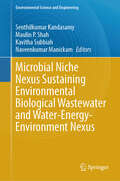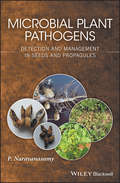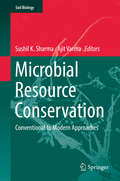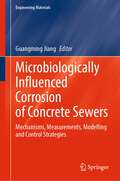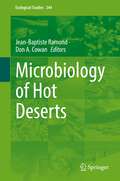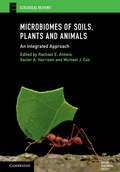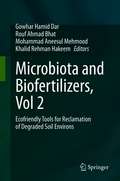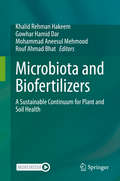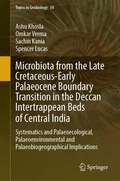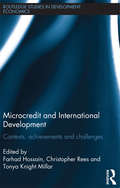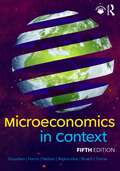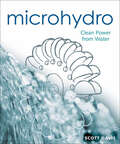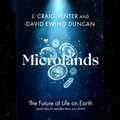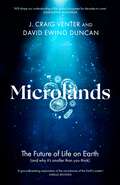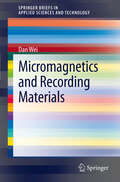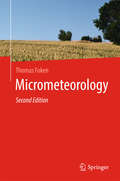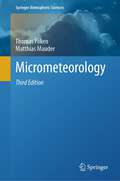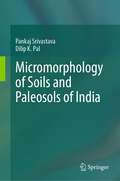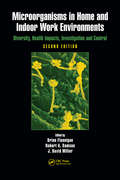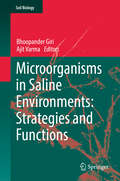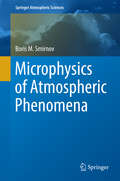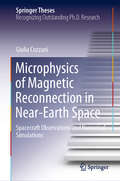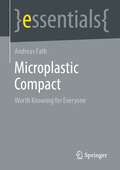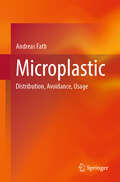- Table View
- List View
Microbial Niche Nexus Sustaining Environmental Biological Wastewater and Water-Energy-Environment Nexus (Environmental Science and Engineering)
by Maulin P. Shah Senthilkumar Kandasamy Kavitha Subbiah Naveenkumar ManickamIn most of the industries, industrial effluent treatment plants are playing vital roles to ensure the efficient management of industrial effluent for supporting sustainable development of our society. Due to the technological development, new concepts about future wastewater management are being incorporated by process industries in the whole world, including recyclable resources and energy/nutrient recovery from industrial effluent, etc. However, conventional treatment methods including biotechnological methods used in treatment plants are facing a lot of difficulties due to the strict discharging norms and coming out of new-fangled pollutants. Recently, a novel concept microbial niche nexus sustaining biological wastewater treatment was introduced, which can accomplish the significant removal of toxic emerging pollutants by different microbial communities, with the concern of other components like integrated and healthy ecosystem. The book focuses on research related to future potential and progress of microbial niche-based environmental biotechnology such as microbial enrichment, microbial function, system design, new technological developments and its applications. Besides, the book reviews important interconnections between water, energy, and the environment as security in water and energy, and the environment is associated with human beings, natural resources, economic, and environmental sustainability. In addition, the book describes innovative green technologies with the aim of enhancing the present state-of-the-art technologies in the various fields like water, energy, the environment, and the related potential fields of industrial wastewater treatment.
Microbial Plant Pathogens: Detection and Management in Seeds and Propagules
by Perumal NarayanasamyHealthy seeds and propagules are the basic requirement for producing good grains, fruits and vegetables needed for human survival and perpetuation. Dispersal of microbial plant pathogens via seeds and propagules has assumed more importance than other modes of dispersal, as infected seeds and propagules have the potential to become the primary sources of carrying pathogen inoculum for subsequent crops. Several diseases transmitted through seeds and propagules have been shown to have the potential to damage economies as a result of huge quantitative and qualitative losses in numerous crops. Hence, it is essential to rapidly detect, identify and differentiate the microbial plant pathogens present in seeds and propagules precisely and reliably, using sensitive techniques. Microbial Plant Pathogens: Detection and Management in Seeds and Propagules provides a comprehensive resource on seed-borne and propagule-borne pathogens. Information on the biology of microbial pathogens, including genetic diversity, infection process and survival mechanisms of pathogens and epidemiology of diseases caused by them, are discussed critically and in detail to highlight weak links in the life cycles of the pathogens.Development of effective disease management systems, based on the principles of exclusion and eradication of pathogens and immunization of crop plants to enhance the levels of resistance of cultivars to diseases, has been effective to keep the pathogens at bay. The need for production of disease-free seeds/propagules has been emphasized to prevent the carryover of the inoculum to the next crop or introduction of the pathogens to other locations. Effectiveness of adopting simple cultural practices and development of cultivars resistant to diseases through traditional breeding methods or biotechnological approach have resulted in reducing the pathogen inoculum and disease incidence. Although application of different chemicals may reduce the disease incidence effectively, biological management of crop diseases, employing potential biological control agents have to be preferred to preserve the agroecosystems. Greater efforts have to be made to integrate compatible strategies to enhance the effectiveness of diseases management systems. Protocols appended at the end of relevant chapters form a unique feature of this book to enable the researchers to fine-tune their projects. This 2 volume set provides comprehensive and updated information about the economically-important groups of microbial plant pathogens carried by seed and propagules. Graduate students, researchers and teachers of plant pathology, plant protection, microbiology, plant breeding and genetics, agriculture and horticulture, as well as certification and quarantine personnel will find the information presented in this book useful.
Microbial Resource Conservation: Conventional to Modern Approaches (Soil Biology #54)
by Ajit Varma Sushil K. SharmaThis book covers broad areas in the conservation of microorganisms. It addresses the short, medium and long-term preservation of agriculturally important microorganisms, as well as culture collections and their roles. The respective chapters address topics such as conventional approaches to bacterial, fungal and algal preservation, as well as methods and strategies for preserving recalcitrant microorganisms. Readers will also find the latest insights into the preservation of vesicular-arbuscular (VA) fungi and ecology, diversity and conservation of endophytes, and entamopathogenic fungi. Microbes of animal and dairy origin, their preservation and biosafety issues are also explored. Microorganisms are the silent and unseen majority of life on Earth, and are characterized by a high degree of genetic and metabolic diversity. It is well documented that no branch of science or society is unaffected by microbial interventions. Researchers have documented microorganisms from such extreme and unique environments as deserts and hydrothermal vents, and with specific traits that are currently being exploited in agriculture, industry, medicine and biotechnological applications. Such great potential can only be found in microorganisms. The aim of this book – the first entirely devoted to the conservation of microorganisms, and to regulatory mechanisms for access and benefits sharing as per Biological Diversity (BD) Act 2002 – is to promote awareness of our world’s microbial wealth, and to introduce readers to strategies and methodologies for the conservation of microorganisms, which could ultimately save human life on Earth.
Microbiologically Influenced Corrosion of Concrete Sewers: Mechanisms, Measurements, Modelling and Control Strategies (Engineering Materials)
by Guangming JiangThis book is a unique resource for professionals seeking a comprehensive understanding of microbiologically influenced corrosion in concrete sewers (MICC), which play a critical role in modern urban infrastructure. Corrosion can lead to structural collapse and significant financial losses due to the costly rehabilitation and replacement of damaged sewer systems. In the United States alone, sewer asset losses attributed to corrosion are estimated to reach $14 billion annually.The book provides a cross-disciplinary approach to understanding the physical, chemical, and biological processes that contribute to microbiologically influenced concrete corrosion. Readers will learn about corrosion rate measurement and characterization methods, controlling environmental factors, corrosion prediction models, and mitigation and control strategies. The book also covers the development of corrosion-resistant concrete. Written for civil engineers, environmental engineers, concrete technologists, and sewer operators and managers, this book is both informative and practical. It not only provides fundamental knowledge of the development of corrosion but also offers practical solutions that are economically and environmentally sustainable. By collating a range of corrosion analytics and control measures, this book is an essential reference for anyone seeking to prevent and manage concrete corrosion in sewer systems.
Microbiology of Hot Deserts (Ecological Studies #244)
by Don A. Cowan Jean-Baptiste RamondThis book covers the wider aspects of the microbiology of hot desert soil ecosystems, compiling disparate information from a range of relevant desert soil microbial fields.The reader learns about microbial ecology of the more dominant and possibly most important desert habitats, detailing the phylogenetic and functional diversity of these different habitats as well as their potential role in desert ecosystem ecology. Particular attention is also given to microbial stress adaptation in hot desert soils. Furthermore, it is the first volume in this particular field to cover modern metagenomics technologies that can be applied to studies of all aspects of desert microbial communities. Additionally, the book explores viruses and viral communities, which are among the least studied (and little understood) components of desert soil microbial communities. Particular attention is also given to the roles of desert microbial communities in biogeochemical cycling of carbon, nitrogen and phosphorus. Through this book the reader discovers how desert microbiology has been at the forefront of Astrobiology and how it may be used conceptually in future terraforming strategies. Desert ecosystems are increasingly coming into focus given the impacts of climate change and desertification trends, making this volume particularly timely. Each of the chapters is authored by leading international researchers and is a must-read for microbial ecologists.
Microbiomes of Soils, Plants and Animals: An Integrated Approach (Ecological Reviews)
by Rachael E. Antwis Xavier A. Harrison Michael J. CoxThrough a long history of co-evolution, multicellular organisms form a complex of host cells plus many associated microorganism species. Consisting of algae, bacteria, archaea, fungi, protists and viruses, and collectively referred to as the microbiome, these microorganisms contribute to a range of important functions in their hosts, from nutrition, to behaviour and disease susceptibility. In this book, a diverse and international group of active researchers outline how multicellular organisms have become reliant on their microbiomes to function, and explore this vital interdependence across the breadth of soil, plant, animal and human hosts. They draw parallels and contrasts across hosts in different environments, and discuss how this invisible microbial ecosystem influences everything from the food we eat, to our health, to the correct functioning of ecosystems we depend on. This insightful read also pertinently encourages students and researchers in microbial ecology, ecology, and microbiology to consider how this interdependence may be key to mitigating environmental changes and developing microbial biotechnology to improve life on Earth.
Microbiota and Biofertilizers, Vol 2: Ecofriendly Tools for Reclamation of Degraded Soil Environs
by Khalid Rehman Hakeem Rouf Ahmad Bhat Mohammad Aneesul Mehmood Gowhar Hamid DarThe dependence of present farming on artificial input of “chemical fertilizers” has caused numerous ecological tribulations associated with global warming and soil contamination. Moreover, there is an essential requirement for realistic agricultural practices on a comprehensive level. Accordingly, biofertilizers including microbes have been recommended as feasible environmentally sound solutions for agricultural practices which not only are natural, and cost-effective but also preserve soil environs and important biota of agricultural land. In addition, it enhances the nutrient quantity of soils organically. Microbial biofertilizers promote plant growth by escalating proficient absorption of nutrients for the plants and by providing an excellent disease-fighting mechanism.Agriculture, the backbone of human sustenance, has been put under tremendous pressure by the ever-increasing human population. Although various modern agro-techniques boosted agricultural production, the excessive use of synthetic fertilizers, pesticides and herbicides have proven extremely detrimental to agriculture as well as to the environment in which it is carried out. Besides this some faulty agricultural practices like monoculture and defective irrigation, further complicate the scenario by eliminating biodiversity, increasing the efflux of nutrients into the water bodies, the formation of algal blooms, eutrophication, damaging the water quality and lowering fish stocks. Biofertilizers are the organic compounds applied to crops for their sustainable growth and the sustainability of the environment as the microbiota associated with biofertilizers interact with the soil, roots and seeds to enhance soil fertility. Application of biofertilizers results in the increased mineral and water uptake, root development, vegetative growth and nitrogen fixation besides liberating growth-promoting substances and minerals that help the maintenance of soil fertility. They further act as antagonists and play a pivotal role in neutralising soil-borne plant pathogens and thus, help in the bio-control of diseases. Application of biofertilizers instead of synthetic fertilizers could be a promising technique to raise agricultural productivity without degrading environmental quality. The present book focuses on the latest research approaches and updates from the microbiota and their applications in the agriculture industry. We believe this book addresses various challenges and shed lights on the possible future of the sustainable agricultural system.
Microbiota and Biofertilizers: A Sustainable Continuum for Plant and Soil Health
by Khalid Rehman Hakeem Rouf Ahmad Bhat Mohammad Aneesul Mehmood Gowhar Hamid DarAn increasing population has put tremendous pressure on agricultural productivity to fulfill the demands of human consumption. Numerous agricultural activities and techniques have been developed to raise annual crop production globally. While agriculture has succeeded in enhancing the yearly crop productivity, this achievement is at the cost of environmental degradation by applying synthetic persistent substances, such as industrial fertilizers, pesticides, herbicides, etc. Chemical fertilizers are nearly as destructive as they are productive, causing monocultures and consequences associated with elimination of diversity, nutrient pollution as evidenced by algae blooms, eutrophication, water quality issues, lower oxygen levels and dangers to fish stocks. Therefore, the scientific approach to maintain sustainable fertility in soil and plants is to switch over to biofertilisers.Biofertilisers are compounds of organic matter that are applied to crops for growth and health. Their constituent micro-organisms interact in an ecofriendly manner with the soil, root and seeds of plants, promoting the growth of micro-flora that enhances soil fertility. They are known to play a number of vital roles in soil fertility, crop productivity and production in agriculture. Application of biofertilisers results in increased mineral and water uptake, root development, vegetative growth and nitrogen fixation. They liberate growth promoting substances and vitamins and help to maintain soil fertility. They act as antagonists and play a pivotal role in neutralising the soil borne plant pathogens, thereby assisting in the bio-control of diseases. Application of biofertilisers in lieu of synthetic fertilizers could be the promising technique to raise agricultural productivity without degrading the environmental quality. The present book focuses on the latest research approaches and updates from the microbiota ecosystem and their applications in agriculture industry. It also highlights the great potential and possible future of action of microbiota in the development of sustainable agricultural systems.
Microbiota from the Late Cretaceous-Early Palaeocene Boundary Transition in the Deccan Intertrappean Beds of Central India: Systematics and Palaeoecological, Palaeoenvironmental and Palaeobiogeographical Implications (Topics in Geobiology #54)
by Spencer Lucas Ashu Khosla Omkar Verma Sachin KaniaThis book describes the microbiota of the intertrappean beds in the Chhindwara District, Madhya Pradesh, India. In this work, special emphasis is placed on the microbiota from the Late Cretaceous-Early Palaeocene transition of the central Narmada River region. Recently, the intertrappean beds of the Eastern Deccan Volcanic Province (one of the subprovinces of the Deccan Volcanic Province) have received considerable attention, which resulted in the addition of some significant biotic assemblages to the existing record from the Dindori-Chhindwara area of the province. The biotic assemblages include charophytes, ostracods, foraminiferans, fishes, frogs, lizards, turtles, crocodiles, and mammals. In spite of the recent discoveries, the known fossil record of the Late Cretaceous-Early Palaeocene biota of India is not sufficient and thus does not permit us to speculate on the possible impact of environmental changes triggered by the Deccan volcanic lava flows on the contemporary biota and to precisely document their palaeoecologic, palaeoenvironmental and palaeobiogeographic implications. The recent biotic reports from the intertrappean beds exposed in the Chhindwara region of the Eastern Deccan Volcanic Province clearly indicate that these beds have a vast potential in terms of fossil content, which could reveal new and dissimilar biotic remains when compared to the Western Deccan Volcanic Province. The record of diverse accumulations of freshwater charophytes, brackish to freshwater ostracods, and planktic foraminiferal and fish assemblages from the intertrappean beds of Jhilmili and adjacent areas of Early Danian (P1a) age and lying just north of Chhindwara town and in the heart of peninsular India has intriguing implications for defining the age limits of the basaltic flows. The occurrence of non-marine taxa, for example, algae, molluscs, and vertebrates, associated with brackish water ostracods in the nearby Singpur and Mohgaon Kalan localities of the Chhindwara region, has also raised concerns about the sedimentary environments of these intertrappean beds. The new finds (presented in this book) prove useful for the better understanding of the palaeoecology and palaeoenvironment of the biota and also throw light on various paleobiogeographic models proposed for the northward drifting Indian plate. The microbiotic assemblages of the intertrappean beds of the eastern Deccan volcanic province at District Chhindwara, Madhya Pradesh are documented in this book. The microbiota of the central Narmada River region, the charophytes, ostracods, planktic foraminifera, and fishes, receive special attention in this study.
Microclimate and Local Climate
by Roger G. Barry Barry, Roger G. and Blanken, Peter D. Peter D. BlankenThis book provides an up-to-date, comprehensive treatment of the variables and processes of microclimate and local climate, including radiation balance and energy balance. It describes and explains the climate within the lower atmosphere and upper soil, the region critical to life on Earth. Topics that are covered include not only the physical processes that affect microclimate, but also biological processes that affect vegetation and animals, including people. A geographic tour of the microclimates of the major ecosystems around the world is included. All major biomes and surface types, including urban areas, are examined, and the effects of climate change on microclimate are described. This book is invaluable for advanced students and researchers in climatology in departments of environmental science, geography, meteorology, agricultural science, and forestry.
Microcredit and International Development: Contexts, Achievements and Challenges (Routledge Studies In Development Economics Ser. #92)
by Farhad Hossain Christopher Rees Tonya Knight MillarThis book draws together a set of topical writings on the subject of microcredit that will be of relevance to the work of both researchers and practitioners in the field. In drawing on the experiences of authors from countries and regions throughout the globe, including Cambodia, Barbados and the Caribbean, Mexico, Pakistan, India and Africa, the book examines the subject of microcredit from various perspectives. The book explores the contribution of microcredit to various sectors within the developed and developing worlds and seeks to analyze critically the contributory success and failure factors of microcredit in varying international contexts. By means of evaluating the opportunities and challenges of microcredit, the book provides key lessons about microcredit for international development purposes. More specifically, the authors of the chapters offer a series of insights into microcredit activities as they relate to the real world. For example, in his chapter, David Hulme traces the developing nature of the activities of the highly influential Grameen Bank, that is, from activities focused on subsidised microcredit to more market-based microfinance activities. In their chapter, Johanna Hietalahti and Anja Nygren examine microcredit as a socio-political institution in South Africa and, in doing so, unearth the complex interactions between of rules, logic and power-relations which are relevant to microcredit activities. In another chapter, Asad Ghalib uses the context of Rural Punjab in Pakistan in order to assess the extent to which microcredit-related activities actually reach the poor. Taken together, the chapters in the book provide readers with an opportunity to consider a host of factors connected to microcredit from a genuinely international perspective.
Microeconomics in Context
by Neva Goodwin Jonathan M. Harris Julie A. Nelson Brian Roach Mariano Torras Pratistha Joshi RajkarnikarMicroeconomics in Context lays out the principles of microeconomics in a manner that is thorough, up to date, and relevant to students. Like its counterpart, Macroeconomics in Context, the book is uniquely attuned to economic, social, and environmental realities. The "In Context" books offer an engaging coverage of current research and policy issues from economic inequality and climate change, to taxes and globalization. Key features include: Up-to-date discussions of the impacts of the COVID-19 pandemic on inequality, labor markets, and beyond Analysis of recent trade issues and the implications of Brexit Presentation of policy issues in historical, environmental, institutional, social, political, and ethical contexts—an approach that fosters critical evaluation of the standard microeconomic models Clear explanations of basic concepts and analytical tools, with advanced models presented in optional chapter appendices A powerful graphical presentation of various measures of well-being in the United States and other countries, including income inequality, tax systems, educational attainment, and environmental quality A focus on human well-being from a multidimensional perspective, including traditional economic metrics and factors such as health, equity, and political inclusion A full complement of student and instructor support materials online. The book combines real-world relevance with a thorough grounding in multiple economic paradigms. It is the ideal textbook for modern introductory courses in microeconomics. The book's companion website is available at: www.bu.edu/eci/micro
Microhydro: Clean Power from Water
by Scott DavisMicrohydro features the smallest version of the renewable engery technology dubbed the simplest, most reliable and least expensive way to generate power off grid. Highly illustrated and practical, it is a complete guide to designing and constructing reliable hydroelectric power systems.
Microlands: The Future of Life on Earth (and Why It’s Smaller Than You Think)
by David Ewing Duncan J. Craig Venter'An epic travelogue, brimming with the excitement of discovery. With characteristic panache, Venter unveils the teeming array of bacteria, viruses, and eukaryotes that crowd our planet's oceans' - Siddhartha Mukherjee'This page-turner gives . . . the thrill of seeing our planet's largest universe through the brilliant, intrepid eyes of the scientist who has done more than anyone to unlock the secrets of life' - Martine Rothblatt'A tour de force . . . Venter has expanded biology's horizons. This book explores microbial life on a global scale, providing cutting-edge solutions to problems of environmental change' - Aristides Patrinos'A ripping tale . . . to revolutionize our understanding of our bodies, the oceans, and the planet' - Jack Gilbert'An exhilarating account of how creative science is accomplished' - Sir Richard J. Roberts'[A] fascinating tour of Planet Microbe' - Bill McKibben'Venter and Duncan expand our scope of what it means to be alive' - Jamie Metzl'Inspiring ... change[s] our ideas of how biology is done' - TelegraphUpon completing his historic work on the Human Genome Project in 2002, J. Craig Venter declared that he would sequence the genetic code of all life on earth. Thus began a fifteen-year quest to collect DNA from the world's oldest and most abundant form of life: microbes. Boarding the Sorcerer II, a 100-foot sailboat turned research vessel, Venter travelled over 65,000 miles around the globe to sample ocean water and the microscopic life within.In this book, Venter and science writer David Ewing Duncan tell the remarkable story of these expeditions and of the momentous discoveries that ensued-of plant-like bacteria that get their energy from the sun, proteins that metabolize vast amounts of hydrogen, and microbes whose genes shield them from ultraviolet light. The result was a massive library of millions of unknown genes, thousands of unseen protein families, and new lineages of bacteria that revealed the unimaginable complexity of life on earth. Yet despite this exquisite diversity, Venter encountered sobering reminders of how human activity is disturbing the delicate microbial ecosystem that nurtures life on earth. In the face of unprecedented climate change, Venter and Duncan show how we can harness the microbial genome to develop alternative sources of energy, food, and medicine that might ultimately avert our destruction.A captivating story of exploration and discovery, this book restores microbes to their rightful place as crucial partners in our evolutionary past and guides to our future.
Microlands: The Future of Life on Earth (and Why It’s Smaller Than You Think)
by David Ewing Duncan J. Craig Venter'An epic travelogue, brimming with the excitement of discovery. With characteristic panache, Venter unveils the teeming array of bacteria, viruses, and eukaryotes that crowd our planet's oceans' - Siddhartha Mukherjee'This page-turner gives . . . the thrill of seeing our planet's largest universe through the brilliant, intrepid eyes of the scientist who has done more than anyone to unlock the secrets of life' - Martine Rothblatt'A tour de force . . . Venter has expanded biology's horizons. This book explores microbial life on a global scale, providing cutting-edge solutions to problems of environmental change' - Aristides Patrinos'A ripping tale . . . to revolutionize our understanding of our bodies, the oceans, and the planet' - Jack Gilbert'An exhilarating account of how creative science is accomplished' - Sir Richard J. Roberts'[A] fascinating tour of Planet Microbe' - Bill McKibben'Venter and Duncan expand our scope of what it means to be alive' - Jamie Metzl'Inspiring ... change[s] our ideas of how biology is done' - TelegraphUpon completing his historic work on the Human Genome Project in 2002, J. Craig Venter declared that he would sequence the genetic code of all life on earth. Thus began a fifteen-year quest to collect DNA from the world's oldest and most abundant form of life: microbes. Boarding the Sorcerer II, a 100-foot sailboat turned research vessel, Venter travelled over 65,000 miles around the globe to sample ocean water and the microscopic life within.In this book, Venter and science writer David Ewing Duncan tell the remarkable story of these expeditions and of the momentous discoveries that ensued-of plant-like bacteria that get their energy from the sun, proteins that metabolize vast amounts of hydrogen, and microbes whose genes shield them from ultraviolet light. The result was a massive library of millions of unknown genes, thousands of unseen protein families, and new lineages of bacteria that revealed the unimaginable complexity of life on earth. Yet despite this exquisite diversity, Venter encountered sobering reminders of how human activity is disturbing the delicate microbial ecosystem that nurtures life on earth. In the face of unprecedented climate change, Venter and Duncan show how we can harness the microbial genome to develop alternative sources of energy, food, and medicine that might ultimately avert our destruction.A captivating story of exploration and discovery, this book restores microbes to their rightful place as crucial partners in our evolutionary past and guides to our future.
Micromagnetics and Recording Materials
by Dan Wei"Micromagnetics and Recording Materials" is a book trying to give a systematic theory of computational applied magnetism, based on Maxwell equations of fields and Landau-Lifshitz equations of magnetic moments. The focused magnetic materials are magnetic recording materials utilized in computer hard disk drives. Traditionally, "Micromagnetics" includes the areas of "magnetization curve theory", "domain theory" and "read and write process analyses in recording systems". As Springer Briefs, this book includes the first two areas of micromagnetics. M-H loops of hard magnetic thin film media, soft magnetic layers and Tunneling MagnetoResistive spin valves are solved based on the microstructures of thin films. Static domain structures and dynamic switching processes are analyzed in the arbitrary-shaped magnetic devices such as write head pole tips and magnetic force microscope tips. The book is intended for researchers who are interested in applied magnetism and magnetic recording in all disciples of physical science. Prof. Dan Wei works at Tsinghua University, China.
Micrometeorology
by Thomas FokenThe book focusseson atmospheric processes which directly effect human environments within thelowest 100-1000 meters of the atmosphere over regions of only a few kilometresin extent. The book is the translation into English of the second edition ofthe German book "Applied Meteorology - Micrometeorological Methods". Itpresents, with selected examples, the basics of micrometeorology applied todisciplines such as biometeorology, agrometeorology, hydrometeorology,technical meteorology, environmental meteorology, and biogeoscience. Theimportant issues discussed in this book are the transport processes and fluxesbetween the atmosphere and the underlying surface. Vegetated and heterogeneoussurfaces are special subjects. Theauthor covers the areas of theory, measuring techniques, experimental methods,and modeling all in ways that can be used independently in teaching, research,or practical applications.
Micrometeorology (Springer Atmospheric Sciences)
by Thomas Foken Matthias MauderThe book focuses on atmospheric processes that directly influence human environments within the lower 100–1000 meters of the atmosphere, spanning regions of only a few kilometers in size. It represents the English translation of the fourth edition of the German work titled "Applied Meteorology – Micrometeorological Methods". It provides a fundamental understanding of micrometeorology as applied to various disciplines, including biometeorology, agrometeorology, hydrometeorology, technical meteorology, environmental meteorology, and biogeosciences, through carefully selected examples.A central theme of this book revolves around the crucial issues of transport processes and fluxes between the atmosphere and the underlying surface, with special emphasis on vegetated and heterogeneous surfaces. The authors comprehensively cover theory, measurement techniques, experimental methods, and modeling, presenting these concepts in a manner that can be readily applied for teaching, research, or practical applications.Compared to the second edition, the new features include updates and minor additions in all chapters, as well as selected new content that addresses the challenges posed by climate change.
Micromorphology of Soils and Paleosols of India
by Pankaj Srivastava Dilip K. PalThis monograph covers uniqueness of micromorphology in resolving many important but enigmatic pedological issues such as clay illuviation, formation of pedogenic and non-pedogenic CaCO3, modification of plasmic fabric, contemporary and relict pedogenic processes, polygenesis of soils in Alfisols, Mollisols, Ultisols, Vertisols and Inceptisols of the tropical Indian environments. Chapters in this title also include identification of paleosols, diagenetic overprinting of the pedofeatures in lithified paleosols, and alluvial cyclicity of the fluvial successions. The techniques mentioned in this title are of tremendous value in pedological and geological research for precise and unambiguous definitions of soil taxa to build the national soil information and refine the stratigraphy of the terrestrial sediments. The information is for the benefit the students and researchers of pedology and geomorphology who often come across extreme difficulties in relating to examples applying the principles of soil formation from textbooks devoted almost exclusively to soils of the temperate climates. The format of this publication is arranged for a process-oriented text and figures on micromorphology of the tropical soils and paleosols as a reference for pedologists, earth scientists, M.Sc. and Ph.D. students, and also for land resource managers who are engaged in enhancing the productivity of such tropical soils in India and elsewhere.
Microorganisms in Home and Indoor Work Environments: Diversity, Health Impacts, Investigation and Control, Second Edition
by J. David Miller Robert A. Samson Brian FlanniganIn 2007, scientists estimated the direct cost of diseases associated with mould and dampness on the US population to be in the range of 4 billion dollars, and the indirect costs of lost work and school days are gauged even higher. The US Centers for Disease Control recently concluded that elimination of moisture and mouldy materials in the home def
Microorganisms in Saline Environments: Strategies and Functions (Soil Biology #56)
by Ajit Varma Bhoopander GiriThis book gathers the latest findings on the microbial ecology of saline habitats, plant-microbe interactions under saline conditions, and saline soil reclamation for agricultural use. The content is divided into four main parts: Part I outlines the definition of salinity, its genesis and impacts, and microbial diversity in saline habitats. Part II deals with impact of salinity on microbial and plant life/health. Part III highlights plant – microbe interactions in saline environments, and Part IV describes strategies for mitigation and reclamation of saline soils. The salinization of arable land is steadily increasing in many parts of the world. An excessive concentration of soluble salts (salinity) in soils or irrigation water adversely affects plant growth and survival. This problem is exacerbated in arid and semiarid areas due to their low precipitation and high evaporation rates. In turn, poor management practices and policies for using river water for the irrigation of agriculture crops often lead to the secondary salinization of soils.Considering the growing demands of a constantly expanding population, understanding the microbial ecology and interactions under saline conditions and their implications for sustainable agriculture is of utmost importance. Providing both an essential review of the status quo and a future outlook, this book represents a valuable asset for researchers, environmentalists and students working in microbiology and agriculture..
Microphysics of Atmospheric Phenomena
by Boris M. SmirnovThis bookinvestigates elementary processes in the Earth's atmosphere involving photons, electrons,ions, radicals, and aerosols. It is based on global atmospheric models such asthe standardatmospheric model with averaged atmospheric parameters across the globe and over time,the Earth's energetic balance, and the global electric circuit that allows toanalyze fundamentalatmospheric properties to be analyzed. Rate constants of elementary processes in theEarth's atmosphere, together with measured atmospheric parameters and existing concepts ofatmospheric phenomena, are used in the analysis of global and local atmospheric processes. Atmospheric photoprocesses result from the interaction of solar radiation with theatmosphere and processes involving ions, oxygen atoms, excited atomic particlesand ozonemolecules. Atmospheric electricity as a secondary phenomenon to atmosphericwater circulationresults in a chain of processes that begins with collisions of water aerosolsin differentaggregate states. Cosmic rays are of importance for atmospheric electricity, as they createpositive and negative ions in the air. Air breakdown in an electric field of clouds inthe form of lightning may develop under the influence of cosmic ray-createdseed electrons,which are necessary for electron multiplication in ionization wave-streamers. The upperatmosphere (ionosphere) is formed under solar radiation in a vacuum ultraviolet spectrum,and absorption of this radiation leads to air photoionization. The greenhouse effect isdetermined by atmospheric water, whereas transitions between a water vapor and aerosolsmay lead to a change in atmospheric optical depth. Carbon dioxide contributes in small portions to the atmospheric greenhouse effect. Cosmic rays are of importance foratmospheric discharge, the origin of lightning and cloud formation in the firststage of aerosolgrowth. This book provides a qualitative description of atmospheric properties andphenomena based on elementary processes and simple models.
Microphysics of Magnetic Reconnection in Near-Earth Space: Spacecraft Observations and Numerical Simulations (Springer Theses)
by Giulia CozzaniThis book presents recent advances in the physics of magnetic reconnection, investigated via both in situ spacecraft observations and fully kinetic numerical simulations. Magnetic reconnection is a fundamental process in plasma physics during which the topological reconfiguration of the magnetic field leads to energy conversion and particle energization. The book focuses on the physics of the electron diffusion region (EDR), a crucial region where the electrons are decoupled from the magnetic field and efficiently accelerated by the electric field. By using recent, high-resolution measurements provided by NASA’s Magnetospheric MultiScale Mission (MMS), the book investigates the structure of the EDR at the Earth’s magnetopause. The presented analysis provides evidence for an inhomogeneous and patchy EDR structure. The structure of the EDR appears to be more complex than the in laminar picture suggested by previous observations and simulations. Then, electrons dynamics in the EDR is studied using a novel, fully kinetic Eulerian Vlasov–Darwin model that has been implemented in the Vlasov–DArwin numerical code (ViDA), explained in detail in the book. Lastly, the book covers the testing of this new code, and investigates the contributions of the different terms in the generalized Ohm’s law within the EDR, highlighting the role of the electron inertia term.
Microplastic Compact: Worth Knowing for Everyone (essentials)
by Andreas FathWill we suffocate in our own plastic waste in the coming years? Or will we manage to turn the corner in time? The constantly growing amount of plastic waste is problematic for the environment and for people who consume the plastic waste in the form of microplastics. The author Andreas Fath explains in a scientifically well-founded but generally understandable way what microplastics are, where they come from and what dangers they pose.The translation was done with the help of artificial intelligence (machine translation by the serviceDeepL.com). A subsequent human revision was done primarily in terms of content.
Microplastic: Distribution, Avoidance, Usage
by Andreas FathThe book presents the entire spectrum of the microplastics problem in our waters, from the collection of water samples to their analysis and interpretation. As part of the "R(h)eines Wasser" project, the author swam the Rhine and, based on this experience, addresses a sensitive issue that will occupy humanity for many years to come.
